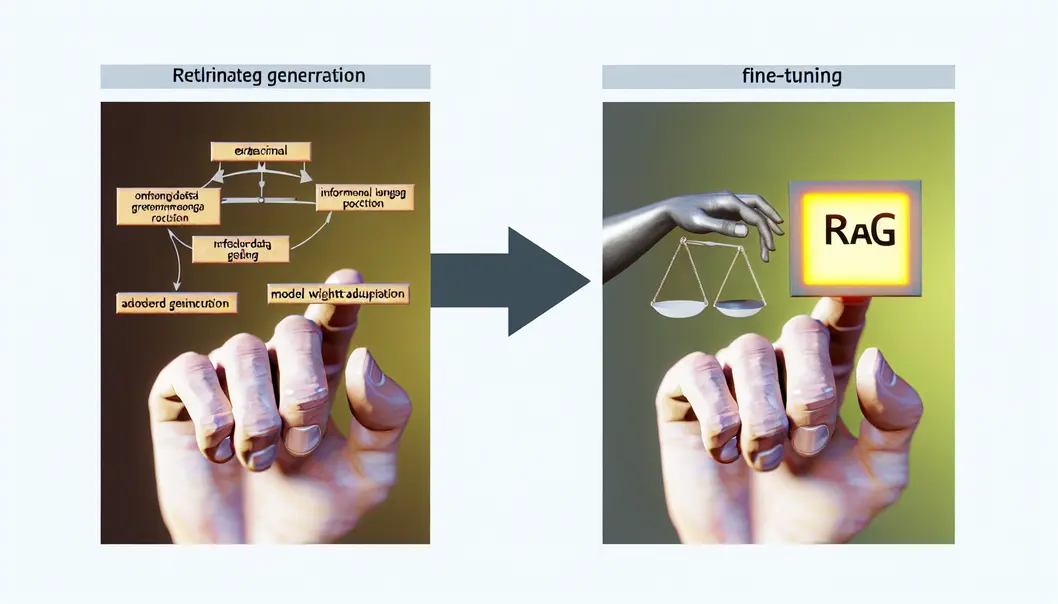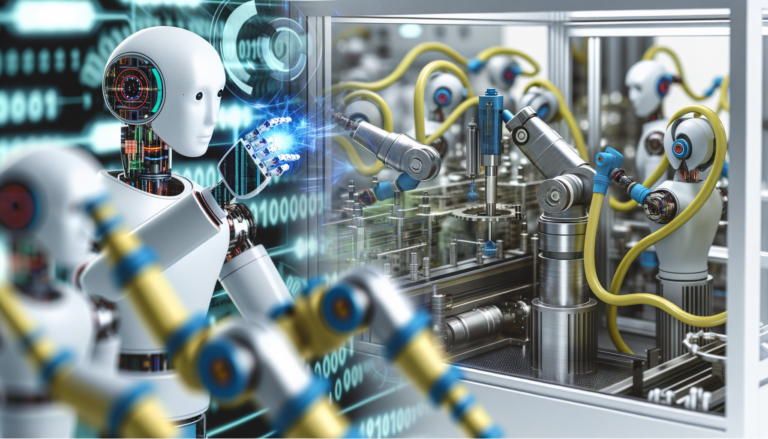As AI continues to transform natural language processing (NLP), developers are often faced with the choice of employing Retrieval-Augmented Generation (RAG) or fine-tuning. Each method offers unique benefits tailored to specific use cases. RAG is lauded for incorporating updated, contextual data during inference, while fine-tuning deeply adapts models to specific domains. Understanding these methodologies not only equips developers with the tools to enhance model performance but also inspires innovative application across diverse fields.
Exploring RAG and Fine-Tuning Comparison: Methodologies and Applications

1. Contextual Depth and Dynamic Access: A Comparative Study of RAG versus Fine-Tuning
In the landscape of large language models, crafting an optimized approach to enhance performance and adaptability is crucial, particularly when comparing two leading methodologies: Retrieval-Augmented Generation (RAG) and fine-tuning. Both methods provide unique benefits and cater to different operational needs, and understanding their mechanics and applications is pivotal for leveraging their full potential.
Retrieval-Augmented Generation (RAG) stands out due to its dynamic integration of up-to-date external data during inference. Introduced by Meta in 2020, RAG enables models to fetch pertinent information from curated databases or the web, enriching the context and grounding responses in real-time data. The methodology unfolds through key phases, starting with knowledge base creation, followed by embedding and retrieval using vector representations, and concluding with the contextual enrichment of the input query. This approach is particularly advantageous for knowledge-intensive tasks and dynamic domains where data evolves rapidly, as it obviates the need for retraining to access current information.
In contrast, fine-tuning excels in scenarios demanding deep domain expertise and static knowledge environments. By training a pre-trained model further on specialized datasets, it imbues the model with domain-specific knowledge, crafting responses that are precise and adhere to the niche terminology required in fields like law or medicine. Fine-tuning involves selecting an appropriate pre-trained model, preparing a domain-specific dataset, and adapting the model’s internal parameters through additional training. While computationally intensive, the resultant model is finely attuned to its domain, offering controlled tone and nuanced reasoning.
When juxtaposing the applications of these methodologies, RAG is seen to thrive in environments of constant flux, such as contemporary news analysis or interactive customer service where accessing real-time data enhances factual accuracy. Meanwhile, fine-tuning finds its strength in stable domains requiring precision and specificity, transforming software into a finely-tuned instrument for specialized tasks.
The operational challenges and benefits also diverge distinctly between the two. RAG’s reliance on the quality of external databases can be both a boon and a bane, as effectiveness hinges on selecting relevant data sources. However, its flexibility in accessing information without retraining is a hallmark benefit. Conversely, the fine-tuning process, while offering domain specialization, contends with high computational costs and potential model instability if parameters are not optimized carefully.
Finally, a hybrid approach embracing the strength of both RAG and fine-tuning can provide a balanced solution that leverages the real-time data accessibility of RAG along with the domain-specific acumen enabled by fine-tuning, optimizing overall model performance for diverse applications. Deeper insights into RAG methodologies can be explored further, providing a richer understanding of its impact on AI development.
Ultimately, the decision between employing RAG or fine-tuning is driven by specific application needs—whether the objective is dynamic knowledge integration or domain specialization underscores the choice of methodology, ensuring models are both well-informed and deeply specialized.
2. Practical Implications and Breakthroughs in RAG and Fine-Tuning Synergies
In the fast-evolving landscape of artificial intelligence, the interplay between Retrieval-Augmented Generation (RAG) and fine-tuning offers a fertile ground for innovation. As two powerful methodologies for optimizing the performance of language models, their individual contributions, when harmoniously integrated, unlock unprecedented potential across various applications.
Retrieval-Augmented Generation (RAG) is particularly adept at handling scenarios requiring dynamic knowledge updates. By embedding real-time data retrieval into the model’s workflow, RAG ensures that language models are not only current but also contextually rich. This characteristic makes RAG an invaluable asset in domains such as customer support systems and real-time analytics, where access to the latest information is crucial. For example, imagine a support bot capable of sifting through external and updated databases to resolve customer inquiries with precision and relevance.
On the other hand, fine-tuning specializes in sculpting pre-trained models to align with specific domain requirements and nuances. This approach enhances the model’s adaptability, making it an indispensable tool for creating domain-specific AI solutions. Fine-tuning can transform a general-purpose language model into an expert communicator in fields as diverse as legal advisory, where nuanced understanding of terminology can vastly improve client interactions.
When these methodologies are combined, they produce a synergistic effect that significantly elevates the capabilities of AI systems. Such hybrid models are not only robust due to their domain-specific fine-tuning but remain contemporaneously accurate by leveraging RAG’s real-time data integration. A practical application of this synergy could be seen in the medical field, where a fine-tuned model aids in understanding complex medical jargon while RAG ensures diagnostic information is based on the latest medical research.
The potential for innovation does not stop at practical applications alone. Researchers are exploring cost-effective implementations that do not compromise on performance. By employing smaller models that utilize both fine-tuning and RAG, organizations can reduce operational costs while maintaining high efficacy in specific applications. This approach democratizes access to cutting-edge AI by making it feasible for smaller enterprises with budget constraints.
Additionally, advancements in real-time data integration facilitated by RAG pave the way for future-ready applications that can rapidly adapt to changes in data streams. These innovations can significantly enhance the responsiveness and accuracy of AI models, especially in industries that rely heavily on time-sensitive data.
In conclusion, the confluence of RAG and fine-tuning opens up new horizons in the AI landscape. Insights into retrieval-augmented generation provide a deeper understanding of how they can be blended effectively to tackle emerging challenges, creating models that are not only intelligent but also attuned to the demands of the present and future.
Final thoughts
In the realm of NLP, both RAG and fine-tuning hold significant potential. While fine-tuning allows for a model to be deeply integrated and aligned with task-specific needs, RAG offers ongoing updates through real-time data integration. By combining these approaches, AI models are well-equipped to handle static as well as dynamic data environments, providing comprehensive solutions suitable for advanced natural language processing tasks.
Ready to elevate your business with cutting-edge automation? Contact AI Automation Pro Agency today and let our expert team guide you to streamlined success with n8n and AI-driven solutions!
About us
AI Automation Pro Agency is a forward-thinking consulting firm specializing in n8n workflow automation and AI-driven solutions. Our team of experts is dedicated to empowering businesses by streamlining processes, reducing operational inefficiencies, and accelerating digital transformation. By leveraging the flexibility of the open-source n8n platform alongside advanced AI technologies, we deliver tailored strategies that drive innovation and unlock new growth opportunities. Whether you’re looking to automate routine tasks or integrate complex systems, Minh Duc TV provides the expert guidance you need to stay ahead in today’s rapidly evolving digital landscape.



